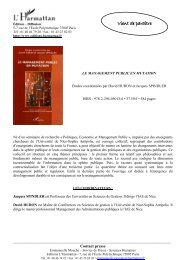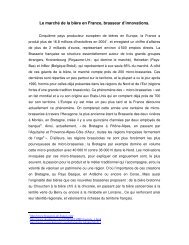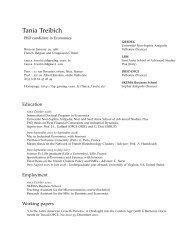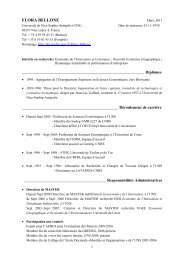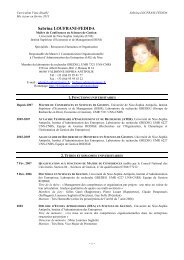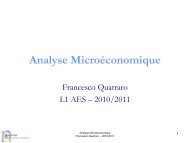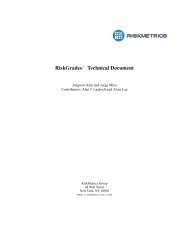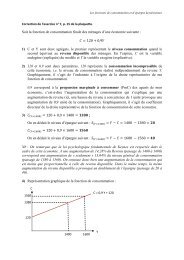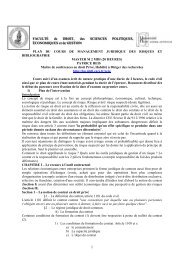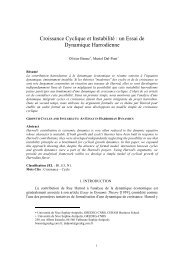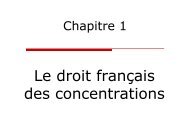Correction Exercice 2 (Consommation et Epargne)
Correction Exercice 2 (Consommation et Epargne)
Correction Exercice 2 (Consommation et Epargne)
Create successful ePaper yourself
Turn your PDF publications into a flip-book with our unique Google optimized e-Paper software.
<strong>Correction</strong> <strong>Exercice</strong> 2 (<strong>Consommation</strong> <strong>et</strong> <strong>Epargne</strong>)<br />
Soit le modèle adm<strong>et</strong>tant les valeurs suivantes :<br />
Y = 50 1<br />
<strong>et</strong> C = 1<br />
72<br />
Y = 100 2<br />
<strong>et</strong> C = 2<br />
112<br />
I = I = 35 0<br />
Question 1 :<br />
- Fonction de <strong>Consommation</strong> :<br />
(1) C = f(Y) = cY+ C 0<br />
A(50 ;72) <strong>et</strong> B(100 ;112)<br />
ΔC<br />
C2<br />
− C1<br />
112 − 72 40<br />
c = = = = c = 4/5 = 0,8<br />
ΔY<br />
Y2<br />
− Y1<br />
100 − 50 50<br />
On remplace dans l’équation (1) :<br />
4<br />
C = Y+ C 0<br />
5<br />
Les coordonnées des points A <strong>et</strong> B doivent vérifier l’équation de la droite :<br />
4<br />
4<br />
C<br />
2<br />
= Y2<br />
+ C0<br />
d’où C0 = C2<br />
− ( Y2<br />
)<br />
5<br />
5<br />
4<br />
C0 = 112 − x100<br />
5<br />
C = 32 0<br />
D’où la fonction de consommation suivante :<br />
4<br />
(1’) C = Y + 32<br />
5<br />
- Fonction d’épargne :<br />
On peut la déduire très facilement de la fonction de consommation puisque :<br />
d’une part, s = 1-c = 1-4/5 s = 1/5<br />
d’autre part, S = − S = 32<br />
0<br />
C 0<br />
0<br />
−<br />
D’où la fonction d’épargne suivante :<br />
1<br />
(2) S = Y − 32<br />
5
Question 2 :<br />
Notre Economie<br />
C,I,S<br />
400<br />
300<br />
200<br />
100<br />
0<br />
-100<br />
0 160 335<br />
Revenu<br />
<strong>Consommation</strong><br />
<strong>Epargne</strong><br />
Investissement<br />
Le seuil de rupture Yr se situe au point d’intersection entre l’axe des abscisses la droite<br />
représentative de la fonction d’épargne. A ce niveau, l’intégralité du revenu disponible est<br />
assignée à la consommation. Il n’y a pas d’épargne résiduelle. Pour le définir<br />
arithmétiquement, il s’agit de résoudre l’équation : S = 0<br />
1<br />
0 Y − 32<br />
Y<br />
r<br />
=<br />
r<br />
5<br />
= 32 × 5 = 160<br />
Pour un revenu global inférieur à 160, nous sommes dans une situation marquée par un<br />
phénomène désépargne caractérisée par une consommation excédentaire par rapport au<br />
revenu disponible (C>Y). Pour faire face à c<strong>et</strong>te consommation excédentaire, les agents<br />
économiques doivent désépargner.<br />
Inversement, pour un revenu global supérieur à 160, nous sommes dans une situation<br />
d’épargne puisque le revenu disponible est supérieur au niveau de consommation global<br />
(Y>C). L’épargne est donc le résidu de l’opération Y-C.<br />
Questions 3 <strong>et</strong> 4 :<br />
I = I = 35<br />
4<br />
32<br />
1<br />
0<br />
C = Y +<br />
S = Y − 32<br />
5<br />
5<br />
4<br />
4<br />
A l’équilibre : DG* = C*+I* = Y * + 32 + 35 DG* = Y * + 67 (3)<br />
5<br />
5<br />
Vérifions qu’à c<strong>et</strong> équilibre S* = I*<br />
Pour ce faire, il convient de tenir un raisonnement inverse consistant à partir du résultat que<br />
l’on cherche à démontrer pour r<strong>et</strong>omber sur un théorème vérifié. Concrètement, on part de la<br />
seconde condition d’équilibre (S* = I* ; en l’espèce, c’est ce qu’il faut démontrer), pour<br />
r<strong>et</strong>rouver la première condition d’équilibre (DG* = OG* C*+I* = C*+S* = Y*).<br />
Si S* = I*, alors S* = 35.
Remplaçons dans l’équation (2):<br />
1<br />
35 = Y * − 32 Y * = (37 + 32 ) x 5<br />
5<br />
D’où Y* = 335<br />
A ce revenu d’équilibre, l’équation (3) doit être vérifiée:<br />
4<br />
4<br />
DG* = C*+I* = Y * + 67 DG * = x 335 + 67<br />
5<br />
5<br />
On trouve :<br />
DG* = 335 = Y* = OG*<br />
Nous sommes donc bien en présence d’un équilibre général keynésien puisque l’on a :<br />
DG* = C*+I* = C*+S* = Y* <strong>et</strong> I *= S*<br />
Ce qu’il fallait démontrer.






